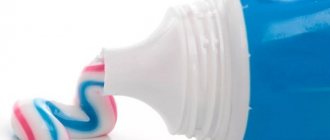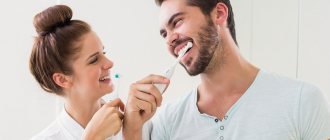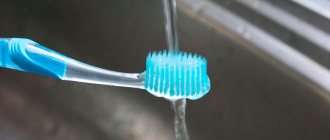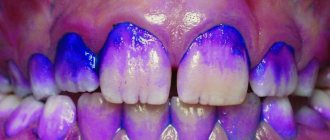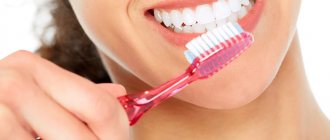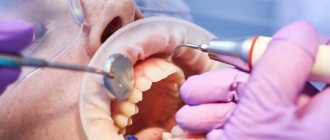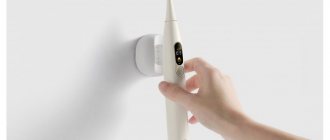Normally, a person has 32 teeth. By the age of thirteen, we acquire the entire set: 8 incisors, 4 canines, 8 premolars and 8-12 molars, but the problems are just beginning. People smoke, eat chocolate and cakes, drink soda and skip dentist appointments. But most importantly, many simply do not know how to brush their teeth properly.
Which brush is better: regular or electric? What should be in the paste? Do I need dental floss and irrigator? How to hold a toothbrush? Reminder answers your top questions about oral hygiene.
What should be in toothpaste?
The main thing is fluorides
, which reduce the risk of caries and strengthen tooth enamel. The paste may also contain active ingredients to reduce tooth sensitivity, against germs and for whitening. But it is not they that cause the most controversy, but the abrasive - particles that physically help remove plaque and stains from teeth and polish the enamel.
Abrasive particles should not be too large, hard or sharp, so as not to scratch teeth and wear out dentin and enamel. Sand, for example, or crushed cuttlefish bones, which were used in pastes before the 1900s, are poor abrasives. Therefore, now there is a standard for abrasiveness - < 250 RDA
(relative dentin abrasivity). Sometimes it is recommended to choose toothpastes with a lower RDA because they are supposedly safer and wear less on teeth. In fact, there is no evidence for this recommendation. For example, the American Dental Association (ADA), which developed the RDA scale, advises choosing any paste with an abrasiveness below 250 RDA. Actually, it’s difficult to find another one on the market now.
Whitening pastes are dangerous for children's teeth.
Since whitening toothpastes are very high in abrasive substances such as silica, clay and sodium, they really should not be used by children. Babies have too thin and weak enamel, which is very easy to damage, which in the future can lead to increased sensitivity of the teeth. It is useful for children to use fluoride-based pastes - they strengthen the enamel and prevent the formation of caries.
How to choose a regular toothbrush?
Make sure the brush is soft
: This is the main thing. If you brush your teeth twice a day and do it correctly, then the soft bristles will cope with plaque; you don’t need extra hardness (it’s actually soft too). The softness also minimizes the risk of injury to teeth and gums.
The head of the toothbrush should ideally be small, only 2-2.5 cm in length
.
The neck is flexible
. But this rule is not as universal as the softness of the bristles. The main thing is that you feel comfortable holding the brush and brushing your teeth with it.
The design of the bristles can be different: with a straight cut (the most common), crossed (criss-cross system), zigzag, interspersed with plastic bristles. There is modest evidence that crossed bristles are slightly better at removing plaque. The studies did not compare plastic bristles with regular bristles. But experts worry that both they and the criss-cross system can harm gums and enamel if you apply too much pressure. Perhaps the best choice is classic straight cut bristles
.
Consumer Reviews
Below are some reviews from customers and dentists. If you have something to say, leave your feedback in the comments below the article, it will be useful to our readers.
Ekaterina Sviridova, Yaroslav.
After the tartar removal procedure, the dentist advised me to change my regular brush to an ultrasonic model.
To be honest, I had never heard of such a device, but the doctor gave some advice on choosing a brush and on the same day I purchased a device from Oral B.
I’ve been using it for almost 3 months, not every day, 4 times a week, so as not to harm my teeth. I am completely satisfied with the brush; it cleans hard-to-reach places well and prevents the formation of tartar. I recommend.
Mikhail But-Gusaim, Moscow.
All ultrasonic brushes from leading brands are expensive, and since I didn’t want to spend large sums on a device that might turn out to be ineffective, I decided to buy a Donfeel HSD-005 device from a Russian manufacturer.
A brush with two operating modes and a comfortable handle, runs on batteries.
The working head has soft fluff, which I immediately identified as a minus, although it really does clean well. It was not possible to get rid of tartar, but overall the effect is good.
Andrey Skomorokh, Stavropol.
I purchased an ultrasonic brush from Philips about three years ago. At that time, it was one of the most budget-friendly and simple models without additional functions such as gum massage or display.
Despite its modest technical characteristics, the brush cleans teeth efficiently and even removes tartar little by little.
It takes a long time to charge (almost a day), but the charge lasts for 2-3 weeks. In three years I’ve used a regular brush 4 times and I don’t plan to go back to it.
What to do if you don’t have a brush and toothpaste at hand?
Then use fluoride mouthwash
. It won’t replace a full cleaning, but it will give you a feeling of freshness and remove at least some of the bacteria.
In general, the rinse is a useful addition to regular teeth brushing: it reaches places that are difficult to clean with a brush and toothpaste. Cosmetic mouthwash (the regular kind found on the supermarket shelf) can temporarily remove bad breath. Therapeutic (available over the counter) can kill bacteria, relieve gum disease (gingivitis), and control plaque and tooth decay. It is better to use it, but select it together with your dentist.
Pay attention to the Sonic Friendly mark
Some pastes may be marked Sonic Friendly as a hint. This means the paste is suitable for use in conjunction with an electric toothbrush. The icon does not determine the quality of the paste, but only gives a hint.
CURAPROX Enzycal 950 toothpaste
Toothpaste CURAPROX PerioPlus SUPPORT chx 0.09%
Megasonex toothpaste
Toothpaste ROCS PRO Electro&Whitening
How about cleaning your tongue? If yes, then with what?
Bacteria that cause tooth decay also multiply on the tongue. But there is no evidence that everyone needs to clean it. A study of 251 subjects found that brushing the tongue helps get rid of bad breath - halitosis.
. But there is no exact data on how often and for how long to clean your tongue, what technique to use.
Manufacturers offer special tongue scrapers
, which do not cause a gag reflex, and recommend brushing your tongue twice a day after brushing your teeth. You should start from the root of the tongue, where most bacteria accumulate. Using gentle pressure, you first need to move from the root of the tongue to its tip, and then treat the side surface, right and left.
Dentist reviews
Today, brushing teeth using sound vibrations at home is available to almost every person.
Unfortunately, I cannot call the invention of the ultrasonic brush an advantage of technological progress.
Indeed, with the advent of electrical devices for oral care, the number of patients complaining of constant pain in the teeth and the development of inflammatory processes has increased.
I do not recommend using such brushes on an ongoing basis.
Dental devices with ultrasonic action have a beneficial effect on the condition of teeth and gums, thoroughly cleaning the oral cavity from pathogenic bacteria, food debris between teeth and plaque.
I believe that fears about the negative impact of ultrasound on the body are groundless, since the power of ultrasonic brushes is low.
It allows waves to penetrate a layer of 4-5 mm - this is enough to safely remove contaminants.
Should I floss?
The question is controversial. The brush removes only 60% of the dirt: it cannot reach the interdental spaces, and a lot of excess remains in them. Therefore, a tool for cleaning interdental spaces is definitely needed.
But does it have to be dental floss? Some experts believe the method is outdated, the evidence for its effectiveness is inconclusive, and flossing can damage gums and teeth if used incorrectly. Interdental brushes can be used instead of dental floss.
or
water irrigator
.
American dentists still recommend dental floss. You should floss once a day, before or after brushing your teeth. Keep in mind that if you're just starting to floss, it may be uncomfortable in the first week and your gums may bleed. This happens because you injure the overgrown gum with the floss. With proper oral hygiene, this tissue is absent, so the discomfort will soon subside.
Tips for choosing
When choosing an ultrasonic brush, pay attention to the following criteria:
- Efficiency. How well the device cleans dentures or other items from dirt. When purchasing in a store, you can always ask a consultant to check the product that you are going to use in the future. Is your purchase made through an online store? – rely on consumer reviews.
- Ease of use. Hold the device in your hand. It shouldn’t be too big, if you can easily grasp the handle and don’t experience discomfort, buy it. But if you can’t completely grasp the handle of the toothbrush, put it back on the shelf. When purchasing a device in an online store, check the diameter of the handle with the seller.
- Functionality. Here we are talking about various functions, for example, the presence of a battery charge indicator, cleaning modes or the presence of additional attachments. Many consumers pay attention to the presence of a teeth brushing timer - a convenient thing if you are always in a hurry.
Does everyone need an irrigator?
First of all, it is needed by those who find it difficult to floss: people with orthodontic structures such as braces and implants, those who have not had their wisdom teeth removed and the space between the teeth is too small to clean with dental floss, and people with disabilities. An irrigator will also come in handy if your gums are sensitive and dental floss causes them to bleed.
Some data say that floss cleans the interdental spaces better, others say that an irrigator does. So the choice between a thread and an irrigator is more a matter of convenience
. You can even use both: this is the most effective way to remove plaque between teeth.
The benefits of brushing your teeth with an electric brush
Plus No. 1: it copes with soft plaque on enamel twice as effectively as a classic brush
The results of clinical studies prove that an electric brush cleans twice as well as a regular one. When you perform the procedure manually, the pressure applied, the nature of the movements and the cleaning time may vary. Your hand gets tired, you are in a hurry, and quality suffers from all this. With an electric device, all you need to do is move the head of the device correctly from one tooth to another. The nozzle rotates to reach the most remote areas and remove soft plaque.
Independent researchers in their works repeatedly draw attention to the fact that people who first used conventional mechanical brushes, and during the experiment electric ones1, were able to improve the condition of the oral cavity, reduce the amount of hard plaque, and improve the condition of the gums. Moreover, these facts were confirmed by dentists.
Plus No. 2: effectively cleans the entire surface
The head of this brush is made to completely cover one or two teeth, depending on the shape of the head. This means that the bristles remove dirt both from the fissures of the molars and in the places where they meet the gums, as well as in the interdental spaces.
Pro #3: Makes oral care more fun
Over time, cleaning becomes a routine, tedious process that we strive to finish as quickly as possible. A modern gadget can open up this procedure from a new perspective. A spectacular appearance, useful functions (for example, a timer), and most importantly, an impressive result will make the daily procedure a pleasant ritual that you will remember with pleasure.
This is especially true for children who are usually too lazy to brush their teeth. Devices for babies often feature bright colors, ultra-soft bristles, and stickers of favorite cartoon characters, as well as other extras (such as synchronization with educational interactive applications) that distract and entertain the child. Thanks to this, brushing your teeth does not cause rejection and is associated with positive emotions. In addition, due to the sounds produced, such advanced devices, according to some independent researchers, can reduce children’s fear of the drill.
Pro #4: Controls your time
Dentists advise spending at least 2-3 minutes cleaning your mouth. If you do this for less than the allotted time, the positive properties of the paste will not have time to take effect, and some of the dirt and plaque will remain on the teeth. Despite this fact, many people do not keep track of how much time they spend cleaning. An electric brush helps control this important point. Many models are equipped with a built-in timer that will tell you when to move on to the next section. This way you will avoid excessive stress on the enamel and achieve a good result.
For more information about what features you should pay attention to when choosing a gadget, read the thematic material: how to choose a good electric toothbrush for an adult.
Should you brush your teeth before or after breakfast?
Better after: then the less food debris, bacteria and saliva on the enamel, the lower the risk of developing oral diseases. But you shouldn’t brush your teeth immediately after breakfast (or any other meal). First you need to rinse your mouth with water, wait an hour (or at least 30 minutes) - and only then start cleaning. Especially if you drank coffee or ate grapefruit: acidic food makes the enamel more vulnerable, and cleaning can harm it. If you don’t have time to take a long break between breakfast and oral hygiene (you need to run to work, for example), brush your teeth before breakfast.
Principle of operation
Cleaning teeth with an ultrasonic brush is carried out by a motor located inside the handle, which triggers a piezoceramic plate that produces oscillatory waves.
Under the influence of ultrasound, the villi begin to move, eliminating bacterial plaque and food particles.
Need to know! During the cleaning process with an ultrasonic type device, the oral tissues are slightly heated.
Thanks to this, the active components of the toothpaste penetrate deep and have a positive effect on the condition of the teeth.
How to brush your teeth with a regular brush?
Hold the brush at a 45° angle to the gum line
. Bacteria and plaque usually hide in the sulcus of the gums. To get rid of them more effectively, the brush head should be slightly tilted towards the furrow. This gives an angle of 45°.
Brush your teeth using short, circular, back-and-forth sweeping movements.
. Not moving up and down - this is a common mistake. Don't press too hard on your teeth; this won't make them cleaner, but it will increase the risk of your teeth becoming hypersensitive and your gums bleeding. Here is an example video with the correct technique.
First, pay attention to the outer surface of the teeth, then to the inner, then to the chewing surfaces. To thoroughly clean the inner surface of the front teeth (a place that is difficult to reach, so do it separately, after chewing surfaces), change the angle and movements: hold the brush vertically and make forward-down movements - in this case they will be correct. Finally, clean your tongue. Even if there is no special scraper, the brush will cope with this quite well.
Electric toothbrushes should not be used continuously.
Not true. It has long been proven that a regular brush is not yet capable of thoroughly cleaning the surface of teeth as an electric one does. In addition, the electric one not only sweeps away accumulated plaque, but also crushes it into tiny particles, preventing it from getting under the gums, and, as a result, eliminates the causes of inflammation in the oral cavity.
How to brush your teeth with an electronic brush?
As with a manual toothbrush, you should hold it at a 45° angle. But the steps are much simpler: you just need to move from tooth to tooth
. First - along the front surfaces, then - along the back and chewing surfaces, and finally - brush along the gum line and clean your tongue. You need to move the brush slowly: each tooth should have a few seconds of brushing. In total, the procedure takes the same amount of time as a manual one: two minutes. Your electric toothbrush may even have a timer set for this time.
Rating of the best Top 5 models
For your information! Different models of electric sonic toothbrushes have a common operating principle, but differ from each other in additional features, power and design.
The most popular today are devices from the brands CS Medica, Hapica and Xiaomi , known for the quality and reliability of their products. Below is a ranking of the best models at the moment.
CS Medica CS-333
Model CS-333 from CS Medica is designed for professional dental care at home.
The appearance of the device is elegant and attractive.
The body of the device is made of durable material, complemented by a soft coating.
Thanks to this, the brush does not slip out of your hands during the procedure.
Know! The manufacturer also took care of the bristles, making them from soft hypoallergenic nylon, which carefully cleans teeth of plaque and does not damage the enamel.
Specifications:
- Maximum speed – 31,000 pulsations per minute.
- The shape of the main nozzle is elongated.
- Nozzles included – 1.
- Types of attachments – standard, whitening.
- Number of operating modes – 5.
- Markers – 5.
- Powered by battery.
- Charging time – 16 hours.
- Operating time after full charge is 14 days.
- There is an addiction function.
- There is a timer.
- Automatic shutdown after 2 minutes.
Need to know! The CS Medica CS-333 brush is ideal for people with hypersensitive teeth.
CS Medica CS-562 Junior
A sonic children's toothbrush that can turn the monotonous procedure of cleaning the oral cavity into a game.
The device is lightweight, compact, with a small working head for comfortable cleaning.
Young children will definitely like it and will help clean their teeth well from dirt.
Keep in mind! Specifications:
- Maximum speed – 16,000 pulsations per minute.
- The shape of the main nozzle is elongated.
- Nozzles included – 2.
- Types of nozzles – standard.
- Number of operating modes – 1.
- Markers – 1.
- Power supply is from batteries.
- Power consumption – 14 W.
- There is a timer.
- Automatic shutdown after 2 minutes.
For your information! The device has a high level of protection against water penetration, so parents do not need to worry about the baby’s safety during the session.
CS Medica CS-262
Electric sound device for daily use, made in gray and white. The device consists of a handle, a battery compartment, and a nozzle with a protective cap .
At the top of the handle there is a button to turn the device on and off, with which you can also switch operating modes.
The villi of the dental product are of medium hardness, which do not injure the gums and mucous membrane of the oral cavity.
Specifications:
- Maximum speed – 33,000 pulsations per minute.
- The minimum speed is 28,000 pulsations per minute.
- The shape of the main nozzle is elongated.
- Nozzles included – 2.
- Types of attachments – standard, whitening.
- Number of operating modes – 2.
- Markers – 2.
- Power supply is from batteries.
- Power consumption – 0.72 W.
- There is a timer.
- Automatic shutdown after 2 minutes.
Hapica Minus ion case
You should know! Sonic ionic brush that cleans teeth without using toothpaste.
Medium-hard bristles polish teeth, making them smooth and snow-white, and remove age spots.
They also
thoroughly clean out bacterial plaque, food particles and other contaminants.
Rounded nylon fibers do not leave scratches or destructive marks, which is a significant advantage of this device.
Specifications:
- Maximum speed – 7000 pulsations per minute.
- The shape of the main nozzle is elongated.
- Nozzles included – 1.
- Types of nozzles – standard.
- Number of operating modes – 1.
- Markers – 1.
- Power supply is from batteries.
- Timer - no.
- Automatic shutdown - no.
The Hapica Minus ion case model is indispensable on the road.
It is convenient to take the device with you, put it in a plastic case, and use it in any conditions.
Xiaomi Mi Electric Toothbrush
Reference! A budget electric toothbrush with dense, medium-hard bristles.
Operating modes are controlled using a single rubberized button, so the device is considered as easy to use as possible.
Specifications:
- Maximum speed – 31,000 pulsations per minute.
- The shape of the main nozzle is elongated.
- Nozzles included – 1.
- Types of nozzles – standard.
- Number of operating modes – 2.
- Markers – 3.
- Powered by battery.
- Charging time – 12 hours.
- Operating time after full charge is 72 minutes.
- Power consumption – 2 W.
- There is an addiction function.
- There is a timer.
- Automatic shutdown after 2 minutes.
- Synchronization with a smartphone – yes.
Important! You can enable additional functions or update the software of your toothbrush through the application installed on your smartphone.
How to use dental floss?
Take 45 cm of dental floss. Wrap most of it around your fingers, leaving 5 cm for cleaning. Hold the floss between your thumb and forefinger and move it up and down
: down - on one side of the tooth, up - on the other.
Be gentle and don't push too hard. Let the movements be light and not sharp, otherwise you may accidentally injure your gums. Move from tooth to tooth, using a new, clean section of floss each time. To finish flossing and pulling it out, use the same up-and-down motion. Here is a video demonstrating the technique.
Electric toothbrushes do not need to be replaced.
Electric brushes themselves can be used without changing for many years, but the attachments on them should be updated from time to time. Despite the durable material of the bristles, they, like any other, wear out. Accordingly, after prolonged use of the same nozzle, the fibers weaken, lose their shape and reduce their effectiveness. By the way, on the latest generation of brushes there is a special indicator that will tell you about the need for replacement - it will change the color of the bristles - so to speak, it will give a signal to action.
